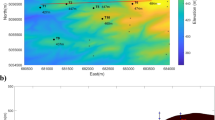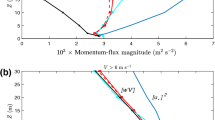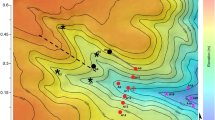Abstract
A case study of the structure of the nocturnal boundary layer (NBL) over complex terrain is presented. Observations were made during the third night of Project STABLE (Weber and Kurzeja, 1991), whose main goal was to study turbulence and diffusion over the complex terrain of the Savannah River Site (SRS) near Augusta, Georgia.
The passage of a mesoscale phenomenon, defined as a turbulent meso-flow (TMF) with an explanation of the nomenclature used, and a composite structure of the lowest few hundred meters over complex terrain are presented. The spatial extent of the TMF was at least 30–50 km, but the forcing is not well understood. The TMF occurred without the presence of a synoptic-scale cold front, under clear conditions, and with no discernible discontinuity in a microbarograph pressure trace. The structure of the NBL over the complex terrain at SRS differed from the expected homogeneous terrain NBL. The vertical structure exhibited dual low level wind maxima, dual inversions, and a persistent elevated turbulent layer.
The persistent elevated turbulent layer, with a spatial extent of at least 30 km, was observed for the entire night. The persistent adiabatic layer may have resulted from turbulence induced by shear instability.
Similar content being viewed by others
References
Arya, S. P. S.: 1988,Introduction to Micrometeorology, Academic Press, Inc., New York. 307 pp.
Caughey, S. J., Wyngaard, J. C. and Kaimal, J. C.: 1979, ‘Turbulence in the Evolving Stable Boundary Layer’,J. Atmos. Sci. 36, 1041–1052.
Hunt, J. C. R., Kaimal, J. C., Gaynor, J. E. and Korrell, A.: 1983, ‘Observations of Turbulence Structure in Stable Layers at the Boulder Atmospheric Observatory’, in J. C. Kaimal (ed.),Studies of Nocturnal Stable Layers at BAO. Report # 4, NOAA/ERL Boulder, Colorado. 129 pp.
Kurzeja, R. J., Berman, S. and Weber, A. H.: 1991, ‘A Climatological Study of the Nocturnal Planetary Boundary Layer’,Boundary-Layer Meteorol. 54, 105–128.
Mahrt, L.: 1989, ‘Intermittency of Atmospheric Turbulence’,J. Atmos. Sci. 46, 79–95.
Schaefer, J. T., Hoxit, L. R. and Chappell, C. F.: 1986, ‘Thunderstorms and Their Mesoscale Environment’, in E. Kessler (ed.),Thunderstorm Morphology and Dynamics, University of Oklahoma Press, Norman, OK 411 pp.
SethuRaman, S.: 1977, ‘The Observed Generation and Breaking of Atmospheric Internal Gravity Waves Over the Ocean’,Boundary-Layer Meteorol. 12, 331–349.
SethuRaman, S.: 1980, ‘A Case of Persistent Breaking of Internal Gravity Waves in the Atmospheric Surface Layer Over the Ocean’Boundary-Layer Meteorol. 19, 67–80.
Stull, R. B.: 1988,An Introduction to Boundary Layer Meteorology, Kluwer Academic Publishers, Boston. 665 pp.
Weber, A. H., and Kurzeja, R. J.: 1991, ‘Nocturnal Planetary Boundary Layer Structure and Turbulence Episodes During the Project STABLE Field Program’,J. Appl. Meteorol. 30, 1117–1133.
Author information
Authors and Affiliations
Rights and permissions
About this article
Cite this article
Parker, M.J., Raman, S. A case study of the nocturnal boundary layer over a complex terrain. Boundary-Layer Meteorol 66, 303–324 (1993). https://doi.org/10.1007/BF00705480
Received:
Issue Date:
DOI: https://doi.org/10.1007/BF00705480




